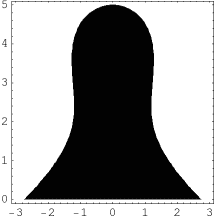| Dror Bar-Natan: Classes: 2002-03: Math 157 - Analysis I: | (263) |
Next: Homework Assignment 24
Previous: Term Exam 4 |
Problem 1. Is there a non-zero polynomial ![]() defined on the interval
defined on the interval ![]() and with values in the interval
and with values in the interval
![]() so that it and all of its derivatives are integers at
both the point 0 and the point
so that it and all of its derivatives are integers at
both the point 0 and the point ![]() ? In either case, prove your
answer in detail. (Hint: How did we prove the irrationality of
? In either case, prove your
answer in detail. (Hint: How did we prove the irrationality of ![]() ?)
?)
Solution. There isn't. Had there been one, we could reach a
contradiction as in the proof of the irrationality of ![]() . Indeed we
would have that
. Indeed we
would have that
![]() ,
hence the integral
,
hence the integral
![]() is not an integer. But
repeated integration by parts gives
is not an integer. But
repeated integration by parts gives


 Problem 2. Compute the volume
Problem 2. Compute the volume ![]() of the ``Black Pawn''
on the right -- the volume of the solid obtained by revolving the
solutions of the inequalities
of the ``Black Pawn''
on the right -- the volume of the solid obtained by revolving the
solutions of the inequalities
![]() and
and ![]() about the
about the ![]() axis (its vertical axis of symmetry). (Check that
axis (its vertical axis of symmetry). (Check that
![]() and hence the height of the pawn is
and hence the height of the pawn is ![]() ).
).
Solution. This is the area of the rotation solid with
radius
![]() bounded by
bounded by ![]() and
and ![]() .
Thus
.
Thus


Problem 3.
Solution.
Problem 4.
Solution.
Problem 5. Do the following series converge? Explain briefly why or why not:
 .
.
Solution.
![]() hence
by the vanishing test the series cannot converge.
hence
by the vanishing test the series cannot converge.
 .
.
Solution.
![]() .
The latter is a multiple of the harmonic series which doesn't converge,
hence the original series doesn't converge either.
.
The latter is a multiple of the harmonic series which doesn't converge,
hence the original series doesn't converge either.
 .
.
Solution. Ignoring the first two terms of the series, which don't change convergence anyway,

 .
.
Solution. The function
![]() is positive at
is positive at
![]() and simple differentiation shows that
and simple differentiation shows that ![]() for
for ![]() , hence
it is increasing, and hence it is positive for all
, hence
it is increasing, and hence it is positive for all ![]() . Thus
. Thus
![]() which is
summable as was shown in class.
which is
summable as was shown in class.
 .
.
Solution. That's a tough one. Here's a solution inspired by the solution to Problem 20 of Spivak's Chapter 23, which by itself is inspired by the proof of the divergence of the harmonic series:


The results. 75 students took the exam; the average grade is 47.4, the median is 46 and the standard deviation is 23.55.